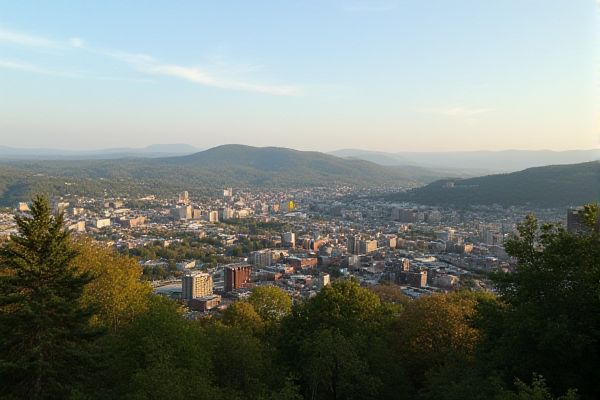
Weather and climate in Pennsylvania: Four distinct seasons. Cold, snowy winters. Hot, humid summers. Moderate rainfall. Occasional thunderstorms. Possible tornadoes. Lake-effect snow in northwest. Appalachian Mountain influence. Varied microclimates. Fall foliage season.
Four distinct seasons.
Pennsylvania experiences a humid continental climate characterized by four distinct seasons, with average temperatures ranging from about 28°F (-2°C) in January to 70°F (21°C) in July, and varying precipitation and snowfall across different regions of the state. The seasonality is marked by warm, humid summers and cold, snowy winters, with the southeastern part being the warmest and the mountainous areas being the coldest. For a detailed overview of the state's climate, visit the Britannica website.
Cold, snowy winters.
In Pennsylvania, the 2024-2025 winter forecast predicts a snowy and cold season in the Pittsburgh area, with above-normal snowfall and colder temperatures, particularly in late January through early February and late February. In contrast, the Philadelphia area is expected to have mild and dry conditions, with temperatures average to slightly warmer than average, except for colder periods in mid-December, January, and February. For a detailed overview, check out the 2025 Winter Forecast that provides region-specific insights and predictions for the upcoming season.
Hot, humid summers.
Pennsylvania experiences hot and humid summers, with an average temperature in July of about 70°F (21°C), and the state receives approximately 40 inches (1,000 mm) of precipitation annually, contributing to the humid climate. The southeastern part of the state, particularly around Philadelphia, has a humid subtropical climate, which is warmer and more humid than the rest of the state. For more detailed information, you can visit the Pennsylvania Climate section on Britannica.
Moderate rainfall.
Pennsylvania experiences moderate rainfall, with an annual average of about 41 inches, ranging from less than 35 inches in the northern parts to more than 45 inches in some areas, and precipitation is fairly evenly distributed throughout the year, with the greatest amounts usually occurring in the spring and summer months. For more detailed insights on Pennsylvania's climate data, visit the Pennsylvania State Climate Office website.
Occasional thunderstorms.
In Pennsylvania, occasional thunderstorms are common, especially during the warmer months, and can be severe, producing wind gusts of 58 miles per hour or higher, hail one inch in diameter or larger, torrential downpours, frequent lightning, and even tornadoes. These storms can cause extensive damage and are often accompanied by flash flooding due to heavy rainfall. For more information and preparedness tips, visit the Severe Weather Awareness Week webpage, which provides valuable insights into understanding and mitigating the impact of such adverse weather events.
Possible tornadoes.
Pennsylvania is experiencing a significant increase in tornado frequency, with a dramatic rise in the past five years. Scientists are diligently studying the link to climate change, which may be contributing to more favorable environments for tornadoes in the region. Tornadoes in Pennsylvania can reach wind speeds of up to 100 miles per hour, and the state ranks in the top 25 for tornado occurrence in the U.S., averaging about 15 tornadoes per year. For more insights into this phenomenon, the Climate Change implications for extreme weather are crucial to understanding the ongoing changes.
Lake-effect snow in northwest.
Lake-effect snow in Northwest Pennsylvania occurs when cold air from Canada passes over the relatively warm waters of Lake Erie, picking up moisture and warmth, leading to intense snow bands that can produce significant snowfall. This phenomenon can result in 2 to 3 inches of snow per hour and often ranges from 2 to 5 feet in total accumulation. The intensity and impact of this weather condition are heavily influenced by wind direction and the physical geography of the area. To learn more about these fascinating weather patterns, visit the National Weather Service website.
Appalachian Mountain influence.
The Appalachian Mountains in Pennsylvania influence the climate by causing greater temperature extremes and a shorter growing season due to nocturnal radiation and cool air masses flowing down the valleys, resulting in a variable freeze-free season ranging from 130 to 175 days depending on the location within the mountainous regions. For more in-depth insights into the climatic conditions of Pennsylvania, visit the Climate Analysis Website, which provides comprehensive data and resources.
Varied microclimates.
Pennsylvania's climate is diverse, straddling two major climate zones. The southeastern corner, including Greater Philadelphia, experiences a Humid Subtropical Climate, which contrasts with the mountainous interior that has a colder, humid continental climate with increased cloudiness and snowfall. To learn more about the specifics of these climatic variations, you can visit the Climate of Pennsylvania page.
Fall foliage season.
Pennsylvania is expected to have a vibrant fall foliage season in 2024, despite summer heat waves, due to recent rains erasing the state's rain deficit and optimal conditions of sunny days with cool nights. The peak foliage is anticipated to start in the northern part of the state in early October and progress southward, with different regions reaching peak colors at various times throughout October. For more detailed updates and forecasts, you can visit the Axios Philadelphia website.
